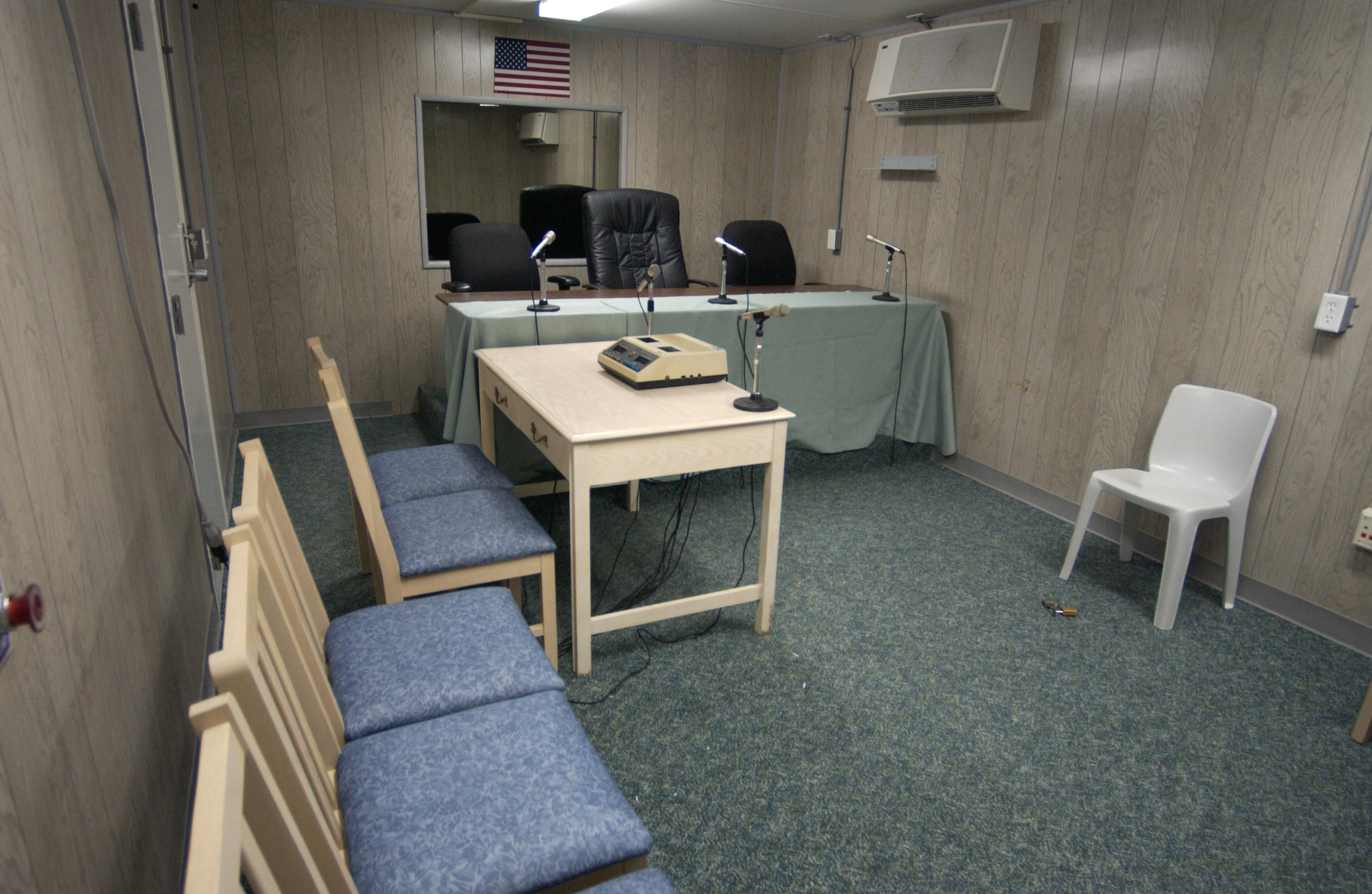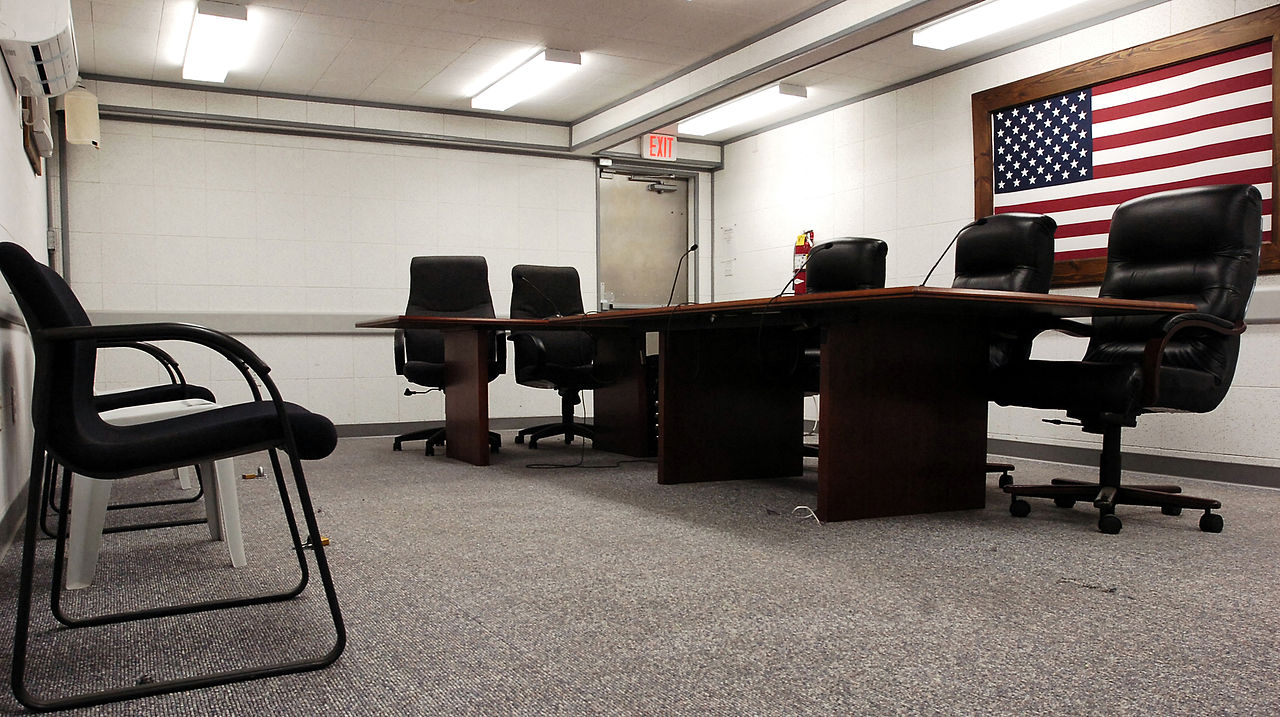Deleted:Muhammad al-Ansi
| The below content is licensed according to Creative Commons Attribution-ShareAlike License contrary to the public domain logo at the foot of the page. It originally appeared on http://en.wikipedia.org. The original article might still be accessible here. You may be able to find a list of the article's previous contributors on the talk page. |
Muhammad Ahmad Abdallah Al Ansi is a citizen of Yemen, held in extrajudicial detention in the United States Guantanamo Bay detention camps, in Cuba.[1] Al Ansi's Guantanamo Internee Security Number is 029. American intelligence analysts estimate that Al Ansi was born in 1975, in Sanaa, Yemen.
Contents
Combatant Status Review Tribunal

Initially the Bush administration asserted that they could withhold all the protections of the Geneva Conventions to captives from the war on terror.[5] This policy was challenged before the Judicial branch. Critics argued that the USA could not evade its obligation to conduct competent tribunals to determine whether captives are, or are not, entitled to the protections of prisoner of war status.
Subsequently the Department of Defense instituted the Combatant Status Review Tribunals. The Tribunals, however, were not authorized to determine whether the captives were lawful combatants -- rather they were merely empowered to make a recommendation as to whether the captive had previously been correctly determined to match the Bush administration's definition of an enemy combatant.
Al Ansi chose to participate in his Combatant Status Review Tribunal.[6]
Shortly after his Tribunal procedures were explained to him Al Ansi expressed concern over how long the Tribunal would last, and asked to leave.
The Tribunal reconvened after he had been removed long enough for the Tribunal's President to review Al Ansi's election form, which recorded that he had originally wanted to attend his Tribunal.
Administrative Review Board hearing

Detainees who were determined to have been properly classified as "enemy combatants" were scheduled to have their dossier reviewed at annual Administrative Review Board hearings. The Administrative Review Boards weren't authorized to review whether a detainee qualified for POW status, and they weren't authorized to review whether a detainee should have been classified as an "enemy combatant".
They were authorized to consider whether a detainee should continue to be detained by the United States, because they continued to pose a threat -- or whether they could safely be repatriated to the custody of their home country, or whether they could be set free.
Al Ansi chose to participate in his Administrative Review Board hearing.[8]
Opening dialogue
Al Ansi requested a copy of the proceedings of his Tribunal. He told his Board that he had requested it five days prior to his Board. He told his Board that other detainees had been given copies of their Tribunals.
Al Ansi's Board went into closed session to consider his request. When they reconvened in open session Al Ansi was told that he would not get access to his Tribunal record because it was classified.
The following factors favor continued detention:
- a. Commitment
- The detainee learned of the Dawa from several Sheikhs he heard in Sanaa, Yemen, including Sheikh Muqbil al Wadi, whom he met at the al Khayr mosque in Sanaa.
- The detainee arranged with two fellow acquaintances to fly to Pakistan and make their way to Afghanistan to teach Islam.
- One of the detainee's friends who accompanied him to Afghanistan obtained 37,000 to 40,000 Riyals from Sheik Muqbil al Wadie [sic].
- The detainee and his acquaintances flew to Dubai, then Karachi, Pakistan, and then to Quetta, Pakistan. The next day, the detainee and his acquaintances crossed the border into Afghanistan.
- The detainee was identified as being present at the Khana Gulem Bechey guesthouse in Afghanistan.
- Another individual said the detainee was in Tora Bora for one month before he was captured.
- 'b. Training
- A senior al Qaida Commander said he recognized the detainee as someone he had seen in either Kabul or one of the camps in Afghanistan, possibly the Farouq camp between 1998 and 2000.
- A senior al Qaida operative provided information on al Qaida participants in a 1999 elite training course at Mes Aynak camp in Lowgar, Afghanistan. He said the detainee was one of Usama Bin Ladin;s bodyguards beginning in mid-2000. Two months before 11 September 2001, be took the detainee and others to Karachi, Pakistan to teach them English and American behaviors. He stated that all of Usama Bin Ladin's bodyguards were arrested two weeks before the fall of Kabul.
- The senior al Qaida operative identied the detainee as one of the martyrs who had been readied for the al Qaida's Southeast Asia hijacking plan of 11 September 2001. He also said Usama Bin Ladin picked United States airlines, citizens, and military installations as targets.
- c. Connections/Associations
- Abu Basir al Yemeni was a close friend with the detainee in Yemen, as well as in Afghanistan. Abu Basir is known to be the personal secretary to Usama Bin Ladein and was a trusted guard.
- The detainee became a bodyguard for Usama Bin Ladin in a late 1999 or early 2000. He remained in that position for approximately one year.
- The detainee was seen in July 2000 guarding Usama Bin Ladin at Kandahar airport. The detainee shared a room with others in Kandahar. This house was known as the "gathering of six." Hamza al Qatari, a close associate of Usama Bin Ladin who dealt with finances, stayed at this compound.
- A senior al Qaida Lieutenant says the detainee was a guard for Usama Bin Ladin. He is certain about seeing the detainee.
- The detainee was a bodyguard for Usama Bin Ladin and was seen in Tora Bora with a handgun and a Beka.
The following primary factors favor release or transfer:
a. The detainee steadfastly denied any involvement in or knowledge of al Qaida activities while in Afghanistan or Pakistan.
b. The detainee claimed he has never received any formal or informal military training and was never issued or carried a weapon while in Afghanistan or Pakistan. The detainee also claimed he had no enmity towards the United States.
Writ of Habeas Corpus
Al Ansi had a writ of habeas corpus, Civil Action No. 08-cv-1923, filed on his behalf.[9]
The Military Commissions Act of 2006 mandated that Guantanamo captives were no longer entitled to access the US civil justice system, so all outstanding habeas corpus petitions were stayed.[10]
On 12 June 2008 the United States Supreme Court ruled, in Boumediene v. Bush, that the Military Commissions Act could not remove the right for Guantanamo captives to access the US Federal Court system. And all previous Guantanamo captives' habeas petitions were eligible to be re-instated. The judges considering the captives' habeas petitions would be considering whether the evidence used to compile the allegations the men and boys were enemy combatants justified a classification of "enemy combatant".[11]
Al-Ansi's petition was filed after the Supreme Court's ruling in Boumediene v. Bush.[9]
In late December 2008 the United States Department of Justice proposed amalgamating fifteen separate petitions, including Al-Ansi's, because they claimed those captives were all captured in Tora Bora.[9]
On December 30th, 2008 United States Department of Justice official Daniel M. Barish informed the court that the DoJ had filed "factual returns" in seven habeas cases, including Al-Ansi's.[12]
References
- ↑ "List of Individuals Detained by the Department of Defense at Guantanamo Bay, Cuba from January 2002 through May 15, 2006". United States Department of Defense. http://www.dod.mil/news/May2006/d20060515%20List.pdf. Retrieved 2006-05-15.
- ↑ Guantánamo Prisoners Getting Their Day, but Hardly in Court, New York Times, November 11 2004 - mirror
- ↑ Inside the Guantánamo Bay hearings: Barbarian "Justice" dispensed by KGB-style "military tribunals", Financial Times, December 11 2004
- ↑ "Annual Administrative Review Boards for Enemy Combatants Held at Guantanamo Attributable to Senior Defense Officials". United States Department of Defense. March 6 2007. http://www.defenselink.mil/transcripts/transcript.aspx?transcriptid=3902. Retrieved 2007-09-22.
- ↑ "Q&A: What next for Guantanamo prisoners?". BBC News. 2002-01-21. http://news.bbc.co.uk/2/hi/americas/1773140.stm. Retrieved 2008-11-24. mirror
- ↑ Summarized transcripts (.pdf), from Muhammad Ahmad Abdallah Al Ansi's Combatant Status Review Tribunal - pages 17-18
- ↑ Spc Timothy Book (Friday March 10 2006). "Review process unprecedented". JTF-GTMO Public Affairs Office. pp. pg 1. http://www.jtfgtmo.southcom.mil/wire/WirePDF/v6/TheWire-v6-i049-10MAR2006.pdf#1. Retrieved 2007-10-10.
- ↑ Summarized transcript (.pdf), from Muhammad Ahmad Abdallah Al Ansi's Administrative Review Board hearing - page 22
- ↑ 9.0 9.1 9.2 Jennifer Cowan (2009-01-08). "Guantanamo Bay Detainee Litigation: Doc 1490 -- Petitioner's Submissions For The January 5, 2008 Joint Filing In Response To The Court's December 17, 2008 Order". United States Department of Justice. http://docs.justia.com/cases/federal/district-courts/district-of-columbia/dcdce/1:2008mc00442/131990/1490/0.pdf. Retrieved 2009-01-12.
- ↑ Peter D. Keisler, Douglas N. Letter (2006-10-16). "NOTICE OF MILITARY COMMISSIONS ACT OF 2006". United States Department of Justice. http://natseclaw.typepad.com/natseclaw/files/Hamdan.28j.letter.pdf. Retrieved 2008-09-30. mirror
- ↑ Farah Stockman (2008-10-24). "Lawyers debate 'enemy combatant'". Boston Globe. http://www.boston.com/news/nation/washington/articles/2008/10/24/lawyers_debate_enemy_combatant/. Retrieved 2008-10-24. mirror
- ↑ Daniel M. Barish (2008-12-30). "Guantanamo Bay Detainee Litigation: Doc 1430 -- NOTICE OF FILING OF FACTUAL RETURN". United States Department of Justice. http://docs.justia.com/cases/federal/district-courts/district-of-columbia/dcdce/1:2008mc00442/131990/1430/0.pdf. Retrieved 2009-01-12.